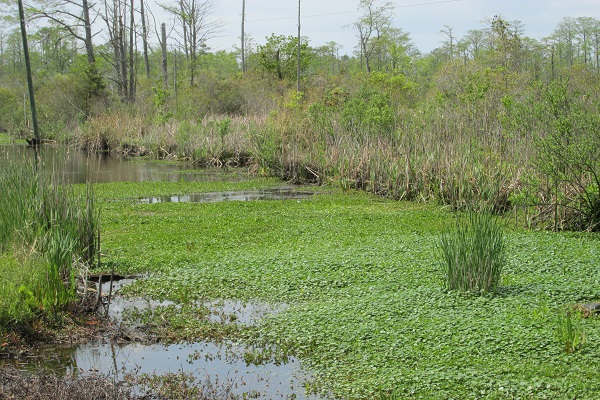Oyster Science on the Edge: Reef Design and Disease Resistance

As the tide begins to recede at Masonboro Sound in Wilmington, Martin Posey and Troy Alphin trudge through knee-deep water and mud.
The North Carolina Sea Grant researchers continue through the mud flat until they reach a reef piled high with oyster shells.
Built by Posey, Alphin and their students at the University of North Carolina at Wilmington, the created oyster reef has a high, zigzagged edge with nooks and crannies.
“The edge gives the fish a channel to swim through,” says Posey, chair of the UNC-W biology department.
The researchers built a total of 24 artificial reefs, which vary in vertical height, edge and complexity.
The reefs are part of a Sea Grant project focusing on how characteristics of intertidal reef morphology, or shapes, affect fishery habitats. UNC-W graduate students Heather Harwell and Joseph Sonnier collaborated on the project.
The dramatic decline in oyster reefs in North Carolina and other states — coupled with the rising recognition of biofiltration, habitat and other ecosystem benefits of oyster reefs — has led to increasing efforts to restore and conserve oyster habitats in North Carolina and other states.
In 2003, more than 260,000 pounds of oyster meat was harvested at a value of more than $1.02 million compared to 724,000 pounds in 1983 valued at more than $1.12 million, according to the N.C. Division of Marine Fisheries (DMF).
“Oysters may have greater economic consequences than their value as a fishery,” says Posey. “Reefs provide critical habitats for commercial and recreational species. The South Atlantic Fishery Management Council and the North Carolina Marine Fisheries Commission have both declared oyster reefs to be an essential fish habitat.”
After studying the reefs for two years, researchers found that high complexity reefs with numerous crevices were used more as blue crab habitat than reefs with fewer crevices. These reefs also were used more by species like pinfish — which are food for other fish species — than other reef shapes.
Oysters settle on top of one another to form clusters and build dense colonies, creating habitats for up to 300 species of plants and animals including, shrimp, speckled sea trout, drum and rockfish. Healthy oysters also filter the water and help to cleanse estuaries of suspended materials, resulting in the removal of excess algae and vegetation growth.
REEF EDGE
In addition, the reef edge affects local currents, as well as the flow of organic matter and amount of nutrients inside and outside the reefs.
The edge disrupts the flow and filtration, leading to the deposition of organic nutrients in and around the reefs, possibly increasing the amount of food for bottom animals eaten by fish and blue crabs, Posey says.
These findings have implications for fishery management.
“In reef restoration for fisheries, we need to pay attention to how the reef is constructed,” Posey adds. “All reefs aren’t the same. More and more reefs are being used for habitat restoration, much like salt marshes are used to restore habitats.”
In the reef restoration project, the scientists left a channel between the reefs instead of constructing one continuous reef.
They found that more aquatic species used patchy reefs — each of which were more than five meters in diameter and had channels between them — than a large continuous area of shells, according to Posey.
While the use of multiple patch reefs is beneficial in oyster habitat restoration, fragmentation — the loss of oyster coverage through degradation, burial of reefs and mortality of oysters — is not useful, according to Alphin, a UNC-W senior research associate.
“When you look at habitat loss throughout the state, increased pollution has caused fragmentation of oyster reefs,” Alphin adds. “In fact, some reefs have become so fragmented that they may no longer function.”
OYSTER RESTORATION PROJECTS
Using the study results, Posey and Alphin are working closely with die N.C. Coastal Federation on site selection, reef design and the sizing of oyster reefs on a number of coastal projects, including the one at Hewlett’s Creek that feeds into Masonboro Sound.
“Martin and Troy recommended four small reefs instead of one large one at our Hewlett’s Creek site so that there would be good water flow between the reefs and also to increase the space for habitat niches,” says Ted Wilgis, N.C. Coastal Federation’s Cape Fear coastkeeper.
“This project is part of an increasing effort by a diverse coalition of private organizations, state and federal agencies and researchers to restore oyster habitats and protect water quality,” says Wilgis. “You can’t restore oysters without improving habitat and water quality.”
In light of the research findings, Sea Grant scientists also are working with the U.S. Army Corps of Engineers and others to initiate an oyster restoration project in the Lower Cape Fear River system. And the study can be applied to intertidal reef restoration in South Carolina and Florida, adds Posey.
DMF will use the data for cultch planting of hard materials like shells and limestone on man-made oyster beds, according to Craig Hardy, DMF Resource Enhancement Section chief. The cultch serves as a substrate for new spat set — the initial attachment of oyster larvae that spawn from June through August.
Baby oysters begin their lives as highly mobile plankton. After the first three weeks, oysters become permanently attached to solid surfaces.
During the summer months, DMF plants shells and rocks to provide additional habitat for larval oysters and clams. Large vessels transport the cultch out to designated sites. The shells are either dumped from a front-end loader or sprayed off the boat deck with a high-power hose. About 500,000 bushels of cultch material are planted annually.
“The Sea Grant research will provide guidance in the way that cultch is deployed in shallow waters from Cedar Island to South Carolina,” says Hardy. “In the past, cultch has been placed on the bottom during the summer to provide additional oyster habitat. We relied on the natural spawn to provide the spat set.”
Scientists have made great strides in moving oyster restoration forward — from research on better placement of sanctuaries to the understanding of needed geometry of the mounds — according to Sara Mirabilio, North Carolina Sea Grant fisheries specialist.
However, Mirabilio says the research will be of limited value unless everyone — from private citizens to restaurant owners — helps to conserve another important natural resource: oyster shells. “Baby oysters settle on oyster shells better than on any other substrate,” she adds.
She cites DMF’s Web site, “One individual may not be able to create a sizable reef, but by pooling our resources, researchers and scientists can construct large reefs in prime oyster-growing areas, enhancing oyster productivity and providing hook-and-line fishing opportunities for the public.”
NATIVE OYSTER
The Eastern oyster (Crassostrea virginicus) provides many ecological and environmental benefits, including filtering the water. The species also contributes to turbidity reduction and the removal of particles in the water column. With less turbidity, more light is transmitted through the water, expanding areas of submerged aquatic vegetation (SAV), an important nursery habitat for a variety of species.
“The health of North Carolina’s oyster populations is a good indicator of the overall health of our estuaries; all prudent measures should be taken to ensure a viable oyster resource,” according to a DMF report.
In North Carolina, oysters are found from the extreme southeastern end of the Albemarle Sound near the northern end of Roanoke Island southward through the Croatan, Roanoke and Pamlico sounds to the estuaries of the southern part of the state to the South Carolina border.
Since before recorded history, the oyster has been an important source of food in coastal North Carolina. When the first Europeans arrived, they were amazed at the number of oysters found.
The Carolina oyster industry hit its ascent in the 1880s, when Baltimore companies built larger canneries in coastal towns. Schooners from outside North Carolina introduced oyster dredges and longer, sturdier tongs into the local oyster industry. Despite later attempts to restrict dredging, most of the damage to oyster beds already had occurred by 1910, according to DMF.
In the 1960s, ecological changes began affecting oyster harvests. Harmful intrusions — disease and polluted waters, combined with other factors — have tainted the once prolific resource.
In recent years, there has been a decline in the number of leases for oysters. In 2003, the state issued 273 leases in comparison to 294 in 1993, according to DMF. The highest density of leases is on the Newport River in Carteret County and Stump Sound in Onslow and Pender counties, according to Hardy.
OYSTER DISEASE
Since the late 1980s, Dermo (Pertinsus marinus) has been responsible for major oyster kills in North Carolina. Harmless to humans, the parasite wears down oysters over many months, killing them before they reach a harvestable size.
The disease first hit the Pamlico Sound in the early 1990s, explains Hardy.
“Since then, it has spread up and down the coast,” he adds. “Dermo seems to be driven more by climatic and salinity-driven issues. From the late 1980s to 2002, North Carolina had drought conditions that provided warm, dry winters, where the water temperature didn’t drop, and the salinity was high. Dermo, like oysters, thrives in medium salinity water.”
There also have been isolated incidents of MSX — a parasite that typically thrives in cooler waters north of North Carolina.
A combination of environmental factors has forced the closing of many oyster beds. Of 1.43 million acres of North Carolina salt water suitable for shellfishing, more than 365,000 acres have been closed for shellfish due to pollution, according to Hardy.
To address the oyster crisis, DMF adopted an oyster management plan in August 2001.
“We are in the process of incorporating recommendations,” says Hardy. DMF staff members have identified areas where only hand-harvest methods will be allowed to provide protection from the effects of mechanical harvest gear, he adds.
“Hand-harvest gear usually does not damage undersized oysters that must be returned to the bottom, where they were caught, nor the structural integrity of the reef system or oyster rock, to the degree that mechanical methods do,” Hardy explains.
In recent years, research on oyster disease has gained momentum.
Through funding from the National Sea Grant College Program, Charles “Pete” Peterson, of the UNC-Chapel Hill Institute for Marine Sciences, and Sean Powers, now of the Dauphin Island Sea Lab in Alabama, are studying the influence of local small-scale variations of landscape setting on Dermo and Eastern oysters.
“A lot of native oysters in North Carolina have been lost to disease in the last 20 or more years,” says Peterson. “We hope this research will help the oyster industry get back on their feet.”
In previous Sea Grant studies, Peterson examined the influence of large-scale environmental factors on oyster disease, including salinity and temperature. The scientists found that there were lower incidences and less severity of Dermo among oysters on the tall reefs than on one-meter reefs degraded by mechanical harvesting.
NEW STUDY
The new National Sea Grant Program study addresses a number of local, small-scale variations in the environment, including water depth, reef orientation, water flow through the reef and the ability of water to transport oyster larvae.
Understanding the relationship between these small-scale effects and oyster disease could aid in oyster reef restoration in areas known to have high disease levels, Peterson says.
The sampling areas include oyster sanctuaries at Wanchese in Dare County, the Pamlico River estuary, the Neuse River estuary, and Cedar Island Bay, Middle Marsh and Bogue Sound, all in Carteret County. “These reefs bring 10 years of history,” says Peterson.
In the Neuse River estuary, the researchers will use historical data on oxygen, temperature and salinity from the MODMON Interdisciplinary Research Project on water quality. The monitoring project is funded by the N.C. Department of Environment and Natural Resources and the UNC Water Resources Research Institute.
In the mid-1990s, Peterson and his colleagues compared the topography of oyster reefs in the Neuse River to an 1880 survey. Through the Sea Grant study, researchers found that vertical structure of reefs had declined in height because of dredging for oysters.
“Specifically, the study showed that oysters located on elevated reefs were above the low-oxygen water mass,” says Peterson. “By being above this water layer, oyster survivorship and growth was high.”
In another Sea Grant-supported study, Peterson and his colleagues compared oyster sanctuaries that were not harvested for up to 10 years and adjacent harvested oyster reefs. The researchers found the proportion of oysters with some levels of Dermo infection and the severity of infection were lower in reefs closed to harvest than in harvested reefs.
Peterson says the new project will provide a valuable and unique database to assess the success of oyster restoration in North Carolina.
“The project will focus on oyster restoration in North Carolina over the last 20 years and help determine which reefs have survived and why,” says Powers, a former postdoctoral researcher at the Institute for Marine Sciences. “Any effort to restore oyster populations must consider how the disease dynamics will influence the survivorship and growth of oysters in a specific area and develop strategies to overcome disease-related problems.”
Now, the only strategies used to combat oyster disease in native populations include the early harvest of small mature oysters and the selection of areas for oyster transplant or restoration that are at least 0.4 kilometers from other infected beds, according to Peterson. Also, managers and fishers can monitor beds infected with Dermo to determine when harvesting is necessary.
Hardy says the Sea Grant study will help guide the DMF oyster restoration in deep subtidtal areas, particularly in the Pamlico Sound and Neuse River.
“The degraded condition of the state’s estuaries and the decline of the oyster population over the last 10 to 15 years has heightened the awareness of the importance of oysters — not only as a seafood product for harvest, but also as a very important link in a healthy, productive ecosystem,” he explains.
“The value of oysters in increasing habitat through reef construction and providing additional areas for SAV and the water quality benefits provided by filter feeding may equal or exceed their value as a seafood product,” adds Hardy.
Because the decline of the oyster stock and degradation of the estuaries over the last 100 years resulted from many factors, Hardy says the rebuilding of the oyster stock — along with the restoration of oyster habitats and estuarine function — will take many years.
To revive the oyster fishery, a variety of issues needs to be addressed, including harvesting and management of reefs.
“Oyster restoration cannot be successful without responsible development, farming and forestry practices, wastewater treatment and stormwater runoff controls,” Hardy adds.
“In short, we have to address all the factors that have contributed to the decline in order to be successful in restoration.”
This article was published in the Autumn 2004 issue of Coastwatch.
For contact information and reprint requests, visit ncseagrant.ncsu.edu/coastwatch/contact/.


